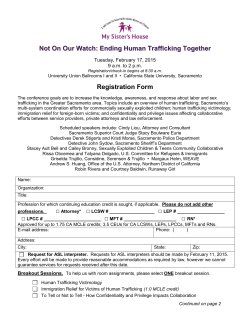
Nexus Between Gender-based Violence and Human Trafficking
THE NEXUS BETWEEN GENDER-BASED VIOLENCE AND HUMAN TRAFFICKING Presently, there are approximately 27 million men, women and children trafficking survivors around the world, many of whom have faced both trafficking and gender-based violence (GBV). 1 Women and girls account for nearly 70 percent of all trafficked individuals. Despite laws passed in an increasing number of countries to toughen penalties, the United Nations Office on Drugs and Crime 2014 report points to growth in the buying and selling of humans. “The exploitation of one human being by another is the basest crime,” the report begins, “and yet, trafficking in persons remains all too common, with all too few consequences for the perpetrators.” Any serious attempt at combating human trafficking must utilize a comprehensive and effective strategy which identifies the key drivers of human trafficking and puts forth a plan of prevention, protection and accountability. GBV is both an important driver of human trafficking and a tool to manipulate and control women, children and even men into both sex work and forced labor across all forms of trafficking. The literature review of close to 50 studies spanning the world from Kosovo to Cambodia and Bangkok to Brazil, ranging in scope from academic research studies to project reports, highlights the nexus between GBV and trafficking. The studies indicate that while there is need for more empirical research to better understand the nature of the relationship between GBV and trafficking, there is significant anecdotal evidence that GBV is a driver in women and girls’ vulnerability to being trafficked. Since close to 70 percent of those trafficked are women and girls, this nexus cannot be ignored and must be effectively addressed. Many of the factors that make women vulnerable to GBV, gender discrimination, poverty, natural disasters, conflict, poor education and health infrastructures, are similar to the root causes of human trafficking and serve as push factors for women and girls’ escape from their homes and into the perilous world of traffickers and exploitation. 2 • • • • 1 Poverty & Violence - Majority of young trafficked women in Kosovo and Costa Rica come from poor backgrounds, often from dysfunctional families with high levels of domestic violence and substance abuse. Armed Conflict – Following armed conflict in Sierra Leon, many girls were reluctant to go home for fear of rejection and stigmatization due to the history of sexual abuse at the hands of the rebels enhancing their vulnerabilities to further exploitation by opportunist traffickers. Displacement - Displaced female populations, who suffer disproportionately from lack of resources and community support, are the most at risk of both GBV and trafficking. These women and girls are susceptible to trafficking when they are in camps because of physical insecurity, food shortages, lack of documentation, and few if any economic opportunities. Social & Cultural Pressures – In countries like Bangladesh, India and Iran, fear of forced marriage, bride burnings, stigmatization after a sexual assault and dowry murders have pushed many young girls to escape from their homes only to fall prey to traffickers and end up in exploitative situations. 3 US State Dept, Trafficking in Persons Report 2013 Winrock International, Addressing Inter-linkages between Gender-Based Violence and Trafficking in Persons to Prevent Reinforcement of Inequalities 2012 3 USAID, Literature Review of Trafficking in Persons and Gender-Based Violence 2009 2 The US government recognizes that comprehensive efforts to reduce human trafficking must include efforts to prevent and respond to GBV due to the intertwined relationship of the two crimes. Human trafficking and GBV are interrelated issues that must be tackled together, as the U.S. government articulated in 2012 through the Administration’s Inter-Agency Strategy to Prevent and Respond to Gender-based Violence and the USAID Gender Equality and Female Empowerment Policy. In 2013, Congress renewed the Trafficking Victims Protection Act (TVPA) as an amendment to the Violence Against Women Act (VAWA), an additional recognition of the nexus between human trafficking and GBV. Efforts to combat human trafficking will be strengthened by the International Violence Against Women Act (IVAWA). IVAWA will build upon the efforts of TVPA by establishing and strengthening institutions that help deter human trafficking abroad. The rise in trafficking world-wide and the failure of governments to effectively curb this trend is due in part to the lack of capacity and focus on effective programs that cut at the root causes of trafficking and on properly training law enforcement and members of the justice system in regards to investigating human trafficking. IVAWA makes ending violence against women and girls a top US diplomatic and foreign assistance priority and incorporates a strategy of prevention, protection and accountability. IVAWA will: • • • Prevent gender-based violence by developing programs that work with local grassroots organizations, civil society, and key stakeholders in the community, including programs that promote social norms change and engage men and boys in creating safer communities; Protect women, men and children by identifying and providing services to survivors once the violence occurs; and Increase accountability by ensuring that perpetrators, recruiters and traffickers, are prosecuted and end impunity by strengthening legal and judicial systems. The war on trafficking must not lose its momentum; IVAWA can serve as an essential arsenal in this war. If you want to eradicate human trafficking, please consider supporting passage of IVAWA.
© Copyright 2025









